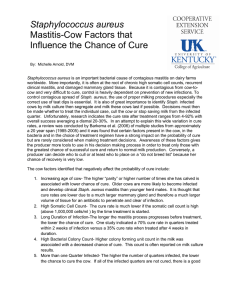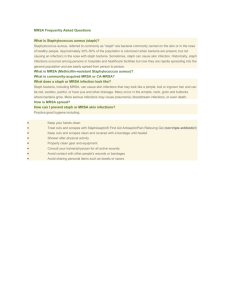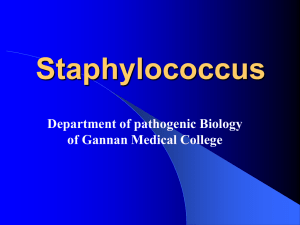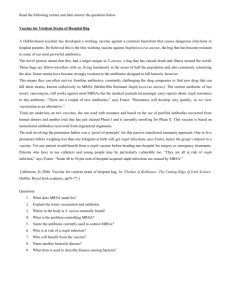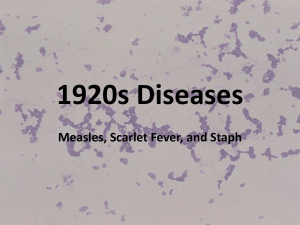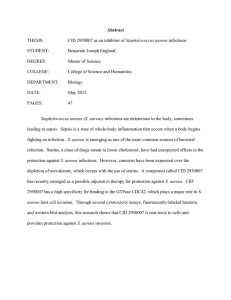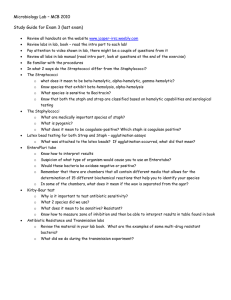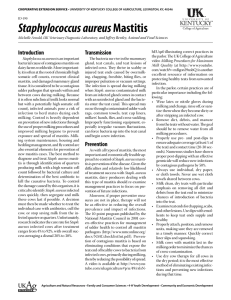Staphylococcus aureus Bacterial Characteristics and Treatment Choices that Influence the Chance of Cure
advertisement
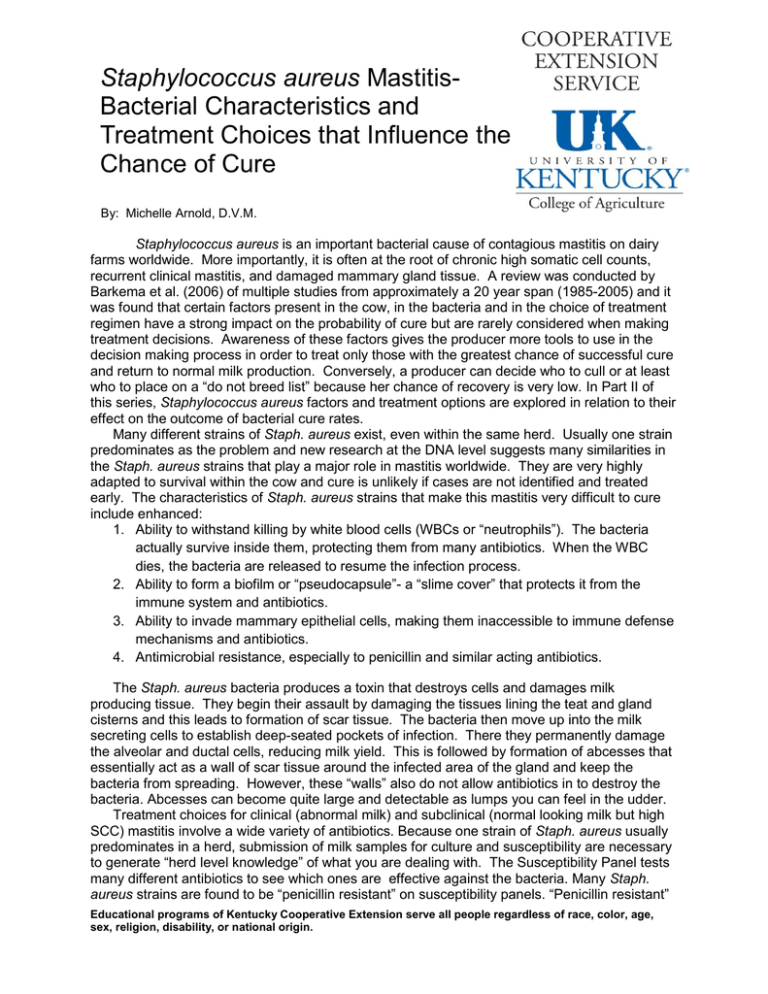
Staphylococcus aureus MastitisBacterial Characteristics and Treatment Choices that Influence the Chance of Cure By: Michelle Arnold, D.V.M. Staphylococcus aureus is an important bacterial cause of contagious mastitis on dairy farms worldwide. More importantly, it is often at the root of chronic high somatic cell counts, recurrent clinical mastitis, and damaged mammary gland tissue. A review was conducted by Barkema et al. (2006) of multiple studies from approximately a 20 year span (1985-2005) and it was found that certain factors present in the cow, in the bacteria and in the choice of treatment regimen have a strong impact on the probability of cure but are rarely considered when making treatment decisions. Awareness of these factors gives the producer more tools to use in the decision making process in order to treat only those with the greatest chance of successful cure and return to normal milk production. Conversely, a producer can decide who to cull or at least who to place on a “do not breed list” because her chance of recovery is very low. In Part II of this series, Staphylococcus aureus factors and treatment options are explored in relation to their effect on the outcome of bacterial cure rates. Many different strains of Staph. aureus exist, even within the same herd. Usually one strain predominates as the problem and new research at the DNA level suggests many similarities in the Staph. aureus strains that play a major role in mastitis worldwide. They are very highly adapted to survival within the cow and cure is unlikely if cases are not identified and treated early. The characteristics of Staph. aureus strains that make this mastitis very difficult to cure include enhanced: 1. Ability to withstand killing by white blood cells (WBCs or “neutrophils”). The bacteria actually survive inside them, protecting them from many antibiotics. When the WBC dies, the bacteria are released to resume the infection process. 2. Ability to form a biofilm or “pseudocapsule”- a “slime cover” that protects it from the immune system and antibiotics. 3. Ability to invade mammary epithelial cells, making them inaccessible to immune defense mechanisms and antibiotics. 4. Antimicrobial resistance, especially to penicillin and similar acting antibiotics. The Staph. aureus bacteria produces a toxin that destroys cells and damages milk producing tissue. They begin their assault by damaging the tissues lining the teat and gland cisterns and this leads to formation of scar tissue. The bacteria then move up into the milk secreting cells to establish deep-seated pockets of infection. There they permanently damage the alveolar and ductal cells, reducing milk yield. This is followed by formation of abcesses that essentially act as a wall of scar tissue around the infected area of the gland and keep the bacteria from spreading. However, these “walls” also do not allow antibiotics in to destroy the bacteria. Abcesses can become quite large and detectable as lumps you can feel in the udder. Treatment choices for clinical (abnormal milk) and subclinical (normal looking milk but high SCC) mastitis involve a wide variety of antibiotics. Because one strain of Staph. aureus usually predominates in a herd, submission of milk samples for culture and susceptibility are necessary to generate “herd level knowledge” of what you are dealing with. The Susceptibility Panel tests many different antibiotics to see which ones are effective against the bacteria. Many Staph. aureus strains are found to be “penicillin resistant” on susceptibility panels. “Penicillin resistant” Educational programs of Kentucky Cooperative Extension serve all people regardless of race, color, age, sex, religion, disability, or national origin. Staphylococcus aureus Mastitis- Bacterial Characteristics and Treatment Choices that Influence the Chance of Cure strains produce beta lactamase, an enzyme that makes penicillin and all other similar acting drugs worthless in the war against mastitis. It is estimated that 30-70% of Staph. aureus strains are penicillin resistant in the US depending on the measuring method used. Interestingly, penicillin resistant strains are far less likely to respond to any type of antibiotic. It is thought that the genes encoding resistance are located in sections of DNA that also aid in the survival against all antibiotics. Therefore the cure rate for all penicillin resistant Staph. aureus is considered very low and should be an important factor for selection of cases to treat. In attempting to improve treatment response, numerous trials have been conducted studying antibiotic routes of administration, durations of therapy, different combinations of drugs, and alternative therapies. Results of these studies indicate the response to treatment of Staph. aureus is often poor but one ray of hope is extended therapy. Research has confirmed that longer treatment regimens (5-8 days) are associated with a higher probability of cure. In a large multinational study published by Deluyker et al (2005), the cure rate for subclinical Staph. aureus mastitis was 6% for those with no treatment; 56% for 2 day Pirlimycin treatment; and 86% for 8 days of Pirlimycin (Pirsue™) therapy. The benefits of extended therapy include 1) a higher proportion of cure, 2) decreased SCC, 3) less risk of spread and 4) improved milk marketability. These must be weighed against the drawbacks of 1)the price of the antibiotic, 2)loss of milk due to long withdrawal times, 3)increased risk of residues in meat and milk and 4) potential to cause more mastitis through repeated infusions in the teat canal, especially with E. coli and Klebsiella. Unfortunately the cost-benefit ratio for most extended therapy regimens is poor. Alternative and/or complementary therapies including immunomodulators and vaccines have not shown consistent results and require more study before recommendations can be made for their use. Dry cow therapy is considered more cost effective in eliminating Staph. aureus infections than lactating treatment but not if the infections have already become chronic by the end of lactation. “Acute” (beginning or first time) Staph. aureus infections may develop any time during lactation and cause an increase in SCC but often the clinical symptoms of udder swelling, hardness and changes in the milk do not show up until calving or early in the next lactation. Treating all four quarters with a commercially available dry cow therapy attacks the bacteria with a higher concentration of antibiotic over an extended period of time, increasing the chance of bacterial cure. However, with increasing pressure to deliver milk with a low bulk tank SCC, it may not be possible to wait until dry-off to treat subclinical mastitis. It is important to bear in mind that treatment decisions regarding Staph. aureus infected cows goes beyond the individual cow. Because it is contagious and often subclinical (milk looks normal), infected animals pose a risk of infection to herd mates at each milking. Your best procedure to diagnose and treat Staph. aureus mastitis is through identification of quarters producing milk with a high somatic cell count followed by culture of them and determination of the susceptibility of that milk. Successful treatment or culling of a Staph. infected cow results in fewer new mastitis cases, less milk thrown away due to antibiotic therapy, lower somatic cell counts in the bulk tank and less milk production loss due to damaged glandular tissue. Educational programs of Kentucky Cooperative Extension serve all people regardless of race, color, age, sex, religion, disability, or national origin.

